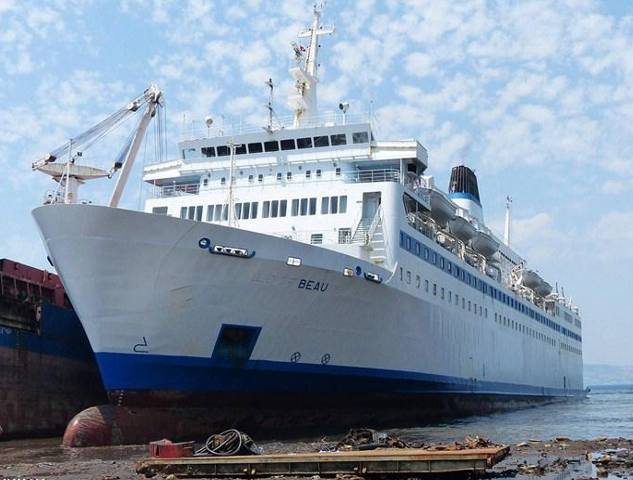The 32nd bulletin of information and analysis on Ship-breaking is published (75 pages). It covers the month of May, June and July 2013. In 8 years, the ship-breaking bulletin has become a reference in this field across the globe. Information and photographs are sent to Robin des Bois by regular or occasional correspondents.
Over the last three months, 271 ships have been sent to demolition. They total over 2.2 million tonnes of metal. 106 (39%) were built in Europe, 88 (32%) belonged to European owners, 241 (89%) were sent to Asia.
The Chinese market has been deserted. The huge rush of commercial ships being sent to India, Pakistan and Bangladesh, at the end-of-their-life, has not decreased. India, Pakistan and Bangladesh do not prohibit the use of asbestos and do not have the adequate facilities for the elimination of PCBs (Polychlorinated biphenyls). PCBs and asbestos are among the dangerous waste generated by ship demolition.
Turkey specialises in the demolition of car ferries and military vessels. Turkey will notably carry out the demolition of the of the Royal Navy’s aircraft carrier HMS Ark Royal. The HMS Ark Royal was sold to an Aliaga ship-breaking yard for over 3 million Euros without prior removal of asbestos. In Aliaga ships are beached, as was the case of the ex-Ile de Beauté owned by Société Nationale Corse-Méditerranée (SNCM) currently being demolished. Ile de Beauté, was registered under the French flag, she arrived in Turkey under the Panamanian flag and renamed Beau. Right up to the end, SNCM lied and let believe that the car ferry would continue her service life in Turkey.
 The ex-Ile de Beauté beached for demolition in Aliaga (Turkey), July 11th, 2013 © Dunkan
The ex-Ile de Beauté beached for demolition in Aliaga (Turkey), July 11th, 2013 © Dunkan
Concerning the case of navy vessels, the French Marine Nationale demolished on a floating dock in the roadstead off Toulon old vessels which can not be towed. The Italian Navy is preparing to make a similar move in the bay of Augusta, Sicily.
In the Canary Islands and off the coast of Valencia, Spain is considering overriding a ban, which came into force end of 2004, on sinking old vessels under the pretext of creating artificial reefs for tourism.
In Morocco, a branch of Arcelor Mittal is hunting down metal from ships at the-end-of-their-life. The company began to collect know-how with the ex-Styval, a reefer, well known to the Concarneau docks in France. According to the available information, the ship was demolished on drydock.
Canada continues to send, in risky conditions, old ships to be demolished in Mexico and Turkey.
Sub-standard ships caught in the administrative web of port controls are pushed to be removed from fleets. Since the 1st edition of Ship-breaking, the Golden Palm is awarded to the Serine, built in Germany in 1972 and detained 19 times in American and European ports before being scrapped in India in May.
Crews abandoned by ship-owners aboard ships destined to be demolished, are exposed to physical and psychological risks that are hard to envisage for those who are unaware of working conditions at sea. This is the case onboard the Iron Monger 3.
The legal context does not encourage owners to change their habits. Only Norway has ratified the Hong-Kong Convention for the Safe and Environmentally Sound Recycling of Ships. The Convention does not prohibit beaching.
The European Union also stands out by her incredible force of inertia. The art of standing still or even going backwards while pretending to advance is mastered by the European Union. The European Parliament courageously approved a legal provision aiming to ban beaching of ships under a European flag in non-member states of the OECD such as India, Pakistan and Bangladesh. Yet, European ship-owners, just as their American, Canadian or even Asian colleagues don’t hesitate to transfer ships destined for demolition under a Saint-Kitts-and Nevis, Togo, Tuvalu or Comoros flag. De-flagging is part of the legal and economic arsenal of ships’ last trips.
Throughout the 75 pages, will be noted the arrival to Pakistan of a diamond dredger coming from South Africa and the simultaneous end of the ex-European Gateway and the ex-Speedlink Vanguard. These two ships collided in the Channel on December 19th 1982. Brought to the surface two months later, the European Gateway was repaired and put back to sea for many more years before finally finding her fate in Turkey this summer. The other ship involved the accident is also presently being demolished in Turkey.
Link to Ship-breaking N°32 (pdf 75 pages – 9,2 Mo)
 Imprimer cet article
Imprimer cet article









